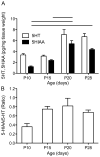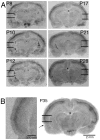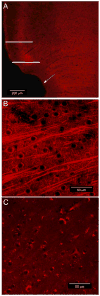Ontogeny of serotonin and serotonin2A receptors in rat auditory cortex
- PMID: 18718516
- PMCID: PMC2943586
- DOI: 10.1016/j.heares.2008.07.009
Ontogeny of serotonin and serotonin2A receptors in rat auditory cortex
Abstract
Maturation of the mammalian cerebral cortex is, in part, dependent upon multiple coordinated afferent neurotransmitter systems and receptor-mediated cellular linkages during early postnatal development. Given that serotonin (5-HT) is one such system, the present study was designed to specifically evaluate 5-HT tissue content as well as 5-HT(2A) receptor protein levels within the developing auditory cortex (AC). Using high performance liquid chromatography (HPLC), 5-HT and the metabolite, 5-hydroxyindoleacetic acid (5-HIAA), was measured in isolated AC, which demonstrated a developmental dynamic, reaching young adult levels early during the second week of postnatal development. Radioligand binding of 5-HT(2A) receptors with the 5-HT(2A/2C) receptor agonist, (125)I-DOI ((+/-)-1-(2,5-dimethoxy-4-iodophenyl)-2-aminopropane HCl; in the presence of SB206553, a selective 5-HT(2C) receptor antagonist, also demonstrated a developmental trend, whereby receptor protein levels reached young adult levels at the end of the first postnatal week (P8), significantly increased at P10 and at P17, and decreased back to levels not significantly different from P8 thereafter. Immunocytochemical labeling of 5-HT(2A) receptors and confocal microscopy revealed that 5-HT(2A) receptors are largely localized on layer II/III pyramidal cell bodies and apical dendrites within AC. When considered together, the results of the present study suggest that 5-HT, likely through 5-HT(2A) receptors, may play an important role in early postnatal AC development.
Figures




References
-
- Araneda R, Andrade R. 5-Hydroxytryptamine2 and 5-hydroxytryptamine 1A receptors mediate opposing responses on membrane excitability in rat association cortex. Neuroscience. 1991;40:399–412. - PubMed
-
- Azmitia EC, Segal M. An autoradiographic analysis of the differential ascending projections of the dorsal and median raphe nuclei in the rat. J Comp Neurol. 1978;179:641–667. - PubMed
-
- Basura GJ, Walker PD. Serotonin 2A receptor mRNA levels in the neonatal dopamine-depleted rat striatum remain upregulated following suppression of serotonin hyperinnervation. Brain Res Dev Brain Res. 1999;116:111–117. - PubMed
-
- Bennett-Clarke CA, Chiaia NL, Rhoades RW. Thalamocortical afferents in rat transiently express high-affinity serotonin uptake sites. Brain Res. 1996b;733:301–306. - PubMed
Publication types
MeSH terms
Substances
Grants and funding
LinkOut - more resources
Full Text Sources
Other Literature Sources

